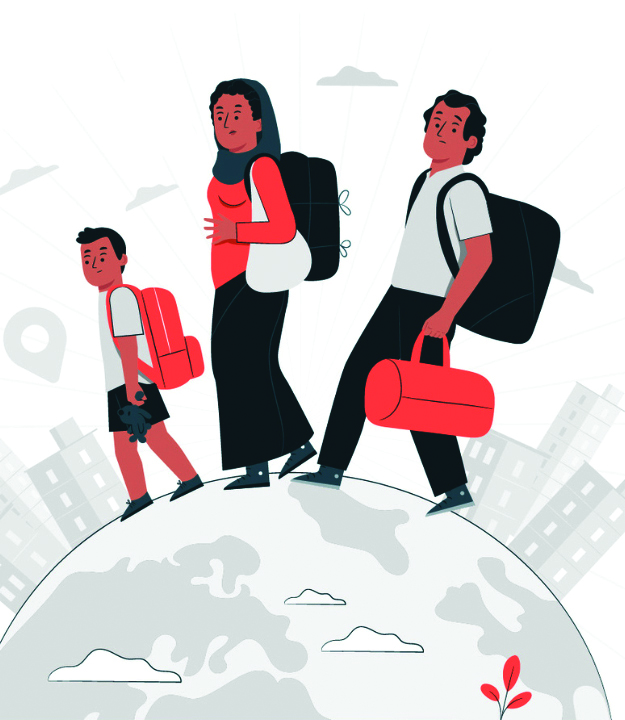India’s remarkable rise as one of the world’s fastest-growing economies has been accompanied by an unexpected phenomenon: a significant surge in emigration. This migration boom has drawn attention to the underlying factors that are propelling individuals to leave behind the opportunities in their homeland and seek greener pastures abroad
By Ranjit Bhushan
- 2022 World Migration Report estimates that India has the highest number of international migrants in the world
- 8,81,254 Indians gave up their citizenship since 2015, the MHA informed in the Lok Sabha in December 2021
- In certain cases, migrants have been forced to surrender their passports and other documents to their employers
- Migration from highly populated UP and Bihar is largely made up of semi-skilled and unskilled labourers
IN June 2023, the Republic of India reached a significant milestone – it was declared by the United Nations Department of Economic and Social Affairs (UN-DESA) to be the world’s most populous country of more than 1.4bn people.

That is, however, just one part of the story. What is of significant interest is that since 2010, the Indian diaspora is now regarded as the largest in the world. Indian migrants are both more numerous and more successful than their Chinese peers and remain an influential source of influence for the Indian government, best epitomised in Prime Minister Narendra Modi’s successful political forays into the US and Europe, where the growing number of Indians have become a powerful constituency.
According to the UN, there were 9.5 million Indian women living outside India in 2020, making up 53 percent of the total Indian migrant population. The top destination countries for Indian women migrants were the United States (2.4 million), Saudi Arabia (1.1 million), United Arab Emirates (0.9 million), Canada (0.6 million), and Australia (0.4 million)
Of the 281m migrants spread around the globe today—generally defined as people who live outside the country where they were born—almost 18m are Indians, according to the latest UN estimates from 2020.
Mexican migrants, who comprise the second-biggest group, number some 11.2m followed by the Chinese abroad, who come a sedate 10.5m – the Indians are clearly ahead in this immigration business.
INDIAN DIASPORA IN NUMBERS
A 2022 World Migration Report released by the UN-DESA (United Nations Department of Economic and Social Affairs), estimates that India has the highest number of international migrants in the world. It found that in 2021, 18 million Indians were living abroad, despite the many travel restrictions on account of the COVID pandemic.
The report by the United Nations-affiliated body estimates that 10 million or about one crore Indians migrated abroad in the period 2000–10.
“Mexico is the second most significant origin country at around 11 million. The Russian Federation is the third largest origin country, followed closely by China (around 10.8 million and 10 million respectively),” said the report.
The UAE appears to have been the most welcoming and had the maximum number of Indians in 2020 (34 lakh). The oil-rich nation presented a good opportunity for both skilled as well as semi-skilled workers to earn a living, the report said.
UAE became the third-largest host of Indian emigrants in 2005, behind the US. But between 1990 and 2020, its share of the Indian population grew by 657 per cent. It has been hosting the largest proportion of Indian emigrants since 2010, the report added.
ECONOMIC FACTORS DRIVING MIGRATION
So, the question to ask is this: With a democratic political system and a comprehensive education structure that has thus far promoted liberalism and plurality, why are intelligent Indian youngsters seeking better opportunities in like-minded economies around the world? What are the triggers that are prompting this exodus?
Explains Naresh M Gehi, Founder & Principal Attorney, Gehis Immigration & International Legal Services: “There are two types of international migration from India: first, workers who are categorised as ‘unskilled’ or ‘semi-skilled’ and who migrate mostly to the Gulf countries. Second, the semi-skilled workers, professionals, and students who migrate to the advanced capitalist countries.”
He explains: “With remittances earned from abroad, families of international migrants have prospered and could contribute to the development of their provinces and country. The knowledge gained by emigrants from India about the economic progress made in other parts of the world, and the social, cultural, political values of other societies, also benefit the country.”
In other words, says Gehi, most upper caste or ‘general category’ people in the country have migrated to the advanced capitalist countries, while the Dalits and backward classes have found their moorings in the Gulf as unskilled labour.
Labourers who travel abroad can see their salaries increase by multiples, particularly since more than 90 percent of India’s workforce is engaged in the informal market. The states of Uttar Pradesh, Bihar, Tamil Nadu, and Kerala are the major sources of Indian emigration.
SOCIETAL INFLUENCE AND PRESSURE
Migration from the northern and highly populated Uttar Pradesh and Bihar is largely made up of semi-skilled and unskilled labourers, whereas immigrants from southern Kerala and Tamil Nadu tend to have higher levels of education and literacy.
Due to the high cost of international migration, and the lack of land and resources for most people from the poorer or backward class families, their participation in international migration is relatively low – as of now.
Estimates suggest that most emigrants to the Gulf send money home to their families. Even some first-generation emigrants to advanced capitalist countries did the same, but the trend is rapidly declining now.
The migrants’ desperation – or desire – to leave India knows no limits. In February this year, The Times, newspaper in the UK, reported that Indians are the third-largest group of migrants crossing into the United Kingdom over the English Channel on risky small boats this year. Officials are scrambling to find out what is driving the surge, which has prompted fears that “thousands more will follow” given the country’s population of 1.4 billion.
In January 2023, about 250 Indian migrants entered the UK by this means, outnumbering the 233 who arrived via small boats in the first nine months of last year. Indians now account for about a fifth of 1180 migrants who have attempted the perilous crossing this year. Afghans were the most numerous, followed by Syrians.
While these are life threatening measures, the other steps adopted by migrants to move out are no less dicey. To cover the costs, families must take loans from institutional and non-institutional sources and sell land, plots, houses, vehicles, farm machinery, jewellery, livestock and much else besides. Household savings must be used and helped, or advance money taken from relatives and friends and employers. No surprise that many families of international migrants are in constant debt.
BRAIN DRAIN VS. REMITTANCE ECONOMY
There is a gap between the migration expenditure incurred and remittances made by international migrants, which directly brings to light the flow of capital out of the country. This is likely to increase soon, the report predicts. According to it, in 2020, total Indian remittances stood at USD 59 million.
According to World Bank figures, an estimated USD 87 billion in official remittances received in India in 2021 represented the world’s largest such flow and amounted to nearly 15 percent of all global transfers to low- and middle-income countries.
Official estimates show that in recent years, remittance transfers from the six Gulf Cooperation Council (GCC) countries—Bahrain, Kuwait, Oman, Qatar, Saudi Arabia, and the United Arab Emirates—have accounted for more than half of all funds remitted to India.
Says Economist Krishna Ballabh: “The high-foreign remittance to India is certainly a good sign. Even though it came down marginally due to Covid, international remittance always aids the economy. In fact, it forms around 3 percent of India’s GDP.”
For Indians, the lust for migrating is all-consuming. The proportion of educated people, for example, among international migrants is high and steadily increasing. These individuals range from secondary school to PhD degree holders. Their emigration clearly highlights the ongoing problem of ‘brain drain’ from India.

The government also issued special bonds allowing NRIs and others to invest billions of dollars in the state. Economic liberalisation since the 1990s has also played a role in the increasing remittance figures, as has the higher skill levels of recent emigrants
The immense power and resources of society have been used for their upbringing and education, but it is benefiting the foreign countries, experts opine.
Of emigrants who leave on student visas, most have a low level of education abroad and many of them do physical work which they would strongly eschew in their home country.
Although some religious institutions and philanthropists abroad do help those who have left the country, most NRI businessmen couldn’t care less.
S Irudaya Rajan, one of India’s leading migration experts, while not doubting the extent of those emigrating, expressed doubts about the figure of 18 million being presented by the World Migration Report. “When the Indian government itself does not have figures of how many Indians there are abroad and if the Ministry of External Affairs (MEA) numbers about how many ‘overseas Indians’ (31 million) is not in consonance with what the United Nations is saying, which figure are we expected to believe,” he queries.
He believes this is a national craze that is not going to go away until Brand India makes a place for itself. “When India’s labour-classes go to the Middle East, the governments in the Gulf are very careful to brand them as temporary wage labour, on let’s say, a two-year contract, upon the expiry of which they have to leave. The US allows Indians to stay on, and you can see that once an Indian reaches those shores, he is unlikely to ever come back,’’ Rajan, who is also Chairman of The International Institute of Migration and Development, Kerala, said.

Money sent as remittances represents a prime tactic for improving financial conditions and diversifying risk, particularly in rural households. The government has taken steps to encourage the inflow of remittances and other types of capital from the diaspora
A total of 8,81,254 Indians gave up their citizenship since 2015, the Ministry of Home Affairs informed the Lok Sabha in December 2021 – and it needs no guess to know that they have become residents of developed countries.
Amarjiva Lochan, governing council member, India Centre for Migration (ICM), a think tank attached to the MEA, is another expert filled with doubts: “Figures presented by the World Migration Council are doubtful. They are designed to show India in a bad light, as if everyone is wanting to get the hell out of here. It is politically motivated.”
Nonetheless, experts like Gehi sum up this frenzy to get out of this country – “by hook or by crook.”
ECONOMIC IMPACT OF REMITTANCES
Money sent as remittances represents a prime tactic for improving financial conditions and diversifying risk, particularly in rural households. The government has taken steps to encourage the inflow of remittances and other types of capital from the diaspora. Since as early as the 1970s, non-resident Indians (NRIs) have been able to keep money in special bank accounts in India, which have been an important source of the growth.
At key moments, the government also issued special bonds allowing NRIs and others to invest billions of dollars in the state. Economic liberalisation since the 1990s has also played a role in the increasing remittance figures, as has the higher skill levels of recent emigrants.
“India has also sought to capitalise on the skills and training well-educated workers acquire abroad, including by easing the path for them and their descendants to return to India or otherwise invest in its development. As an example, many college-educated emigrants who gained experience in Silicon Valley and other tech hubs subsequently used their ties to create a thriving information technology sector in Bangalore,’’ noted Ruchi Singh.
INCREASED EXPOSURE TO GLOBAL OPPORTUNITIES
India is now a top origin country for immigrants in the United States, with new arrivals from India and China outpacing those from Mexico since 2013. This growth has been made possible by the revocation in 1965 of national-origins quotas that had guided the US immigration policy since the 1920s and discriminated against Asians and others not from north-western Europe.
The introduction of the H-1B visa for skilled workers in 1990 was also important; Indian immigrants are regularly the top recipients of these visas. Indian immigrants in the United States tend to be highly educated and have higher incomes than the overall foreign-and US-born populations.
The rapid growth in technology and digital services in the US since the turn of the century needed plenty of educated and English-speaking manpower and Indians were more than ready to step in. Around 27 lakh Indians lived in the US in 2020.
To be sure, there is a flip side: periodic reports reveal the widespread exploitation of Indians working in low- and semi-skilled jobs in some foreign countries. In certain cases, migrants have had to pay exorbitant recruitment charges, been underpaid, or had their wages withheld, and been forced to surrender their passports and other documents to their employers—situations which have been compared to being held hostage. All the while, migrant workers have been forced to endure long hours, abusive treatment, and other poor conditions.
In these conditions, successive Indian governments have initiated interventionist measures to ensure the welfare of low-level migrants. Since adoption of the Emigration Act of 1983, emigrant workers referred to as having Emigration Check Required (ECR) status, often including domestic workers and those in construction, need to obtain clearance from a government office before leaving the country, and foreign companies have needed to obtain certification before recruiting Indians.
The law also attempts to cap service fees charged by recruiters. Emigration checks are only required for certain workers heading to specific countries primarily in the Middle East, which critics claim is part of a short-sighted focus that fails to consider how flows would diversify. Multiple lawsuits have also claimed that the government’s protections are ineffective, particularly with regards to the many recruitment agents who operate illegally.
In 2021, the MEA circulated a draft legislation known as the Emigration Bill 2021, which would replace the 1983 law and alter the recruitment process for foreign work. It is designed to give the government more power and resources to engage with emigrants and serve as their watchdog, including through a new bureaucratic structure.
This fresh effort has faced opposition, for allowing migrant workers to face penalties, failing to limit workers’ fees for recruitment, and remaining silent on issues such as physical and sexual abuse faced by female migrants. Some advocates have instead pushed for a comprehensive rewrite of the law that would more explicitly resemble global ambitions such as those of the Sustainable Development Goals.
THE RISE AND CHALLENGES OF INDIAN WOMEN MIGRANTS
While an increasing number of Indian men move abroad in search of greener pastures and better employment possibilities, a sizable number of Indian women are doing the same.
Indian women have been migrating for various reasons such as education, employment, marriage, family reunification, and humanitarian protection.The number of Indian women who have immigrated to other nations has dramatically increased in the last three decades.
According to the UN, there were 9.5 million Indian women living outside India in 2020, making up 53 percent of the total Indian migrant population. The top destination countries for Indian women migrants were the United States (2.4 million), Saudi Arabia (1.1 million), United Arab Emirates (0.9 million), Canada (0.6 million), and Australia (0.4 million).

This is a much under-reported facet of Indian migration until now. Clearly, the passage of Indians to escape the system is assuming dynamic proportions. Its final contours are not yet decipherable
These women migrants have diverse backgrounds and experiences, ranging from highly skilled professionals such as doctors, engineers, and IT workers, to low-skilled workers such as domestic helpers, caregivers, and construction workers. Some of them migrate independently or with their families, while others migrate through marriage or recruitment agencies.
However, Indian women migrants face specific challenges and vulnerabilities such as discrimination, exploitation, abuse, isolation, and lack of access to rights and services.
This is a much under-reported facet of Indian migration until now. Clearly, the passage of Indians to escape the system is assuming dynamic proportions. Its final contours are not yet decipherable.
As the country’s diaspora continues to expand, the importance of finding a balance between the potential of migration and the protection of migrants will become increasingly important.
THE PUSH AND PULL FACTORS OF EXODUS
BETTER QUALITY OF LIFE: People aspire for a better quality of life. This includes an unpolluted environment, 24/7 electricity and drinking water at home.
SOCIAL PRESSURE: Settling abroad is considered successful. Owning a shop in the USA is more successful than owning a similar shop in India.
SEARCH FOR SUITABLE MATCHES: In matrimonial advertisements, it is not uncommon to see people searching for `only those who are settled abroad.’
LACK OF RESEARCH OPPORTUNITIES IN THE COUNTRY: Those interested in cutting edge research want to move to the US, Canada, which facilitates migration, or Europe. Many Indian government funds discourage money to be spent on going abroad, because they believe it will be misused.
LACK OF SUPPORT FOR ENTREPRENEURSHIP: Although it is picking up, India has a long way to go. Many ideas such as Facebook, Twitter, Amazon, Uber, Quora, etc. are very simple ideas, but they get venture funding and fructify.
EXTREME CORRUPTION: On a monthly basis a big scam surfaces, leading to suspicion among bright young minds, who become cynical about the system.
SOCIAL INJUSTICE: Some feel discriminated against because of their caste (lower or upper), or their religion, and prefer to move to developed countries, where they expect that discrimination to be less or hopefully, non-existent.
GROWING AWARENESS ABOUT OTHER COUNTRIES: Indians are now more aware of opportunities overseas than they were in the past. With more Indians travelling to different parts of the world, there is more information available about other countries.
THE GROWING INDIAN ECONOMY: For NRIs, new employment options have been made possible by India’s expanding economy and rising demand for skilled labour. The expansion of India’s start-up and IT industries has also made a significant impact on the surge in return migration.
Writes Ruchi Singh, an Assistant Professor of Research at the L. N. Welingkar Institute of Management Development and Research in Bengaluru, in the Migration Policy Institute journal: “India’s status as the world’s largest migrant-origin country is despite the presence of caste barriers, extended family arrangements, traditional values, low nationwide levels of education, and the predominance of semi-feudal relationships—all of which might suggest a disinclination towards international mobility.”
That the Indian governments have over a period, used these emigres as pressure lobbies can scarcely be doubted. They have built multiple systems for engaging with its emigrant population and the many descendants who call India their ancestral home.